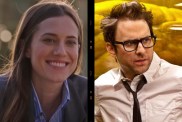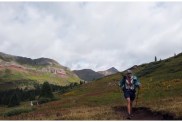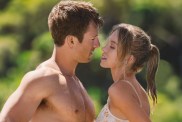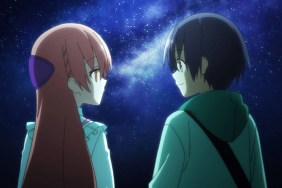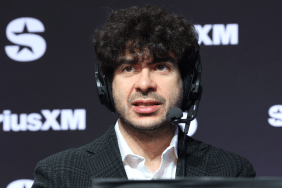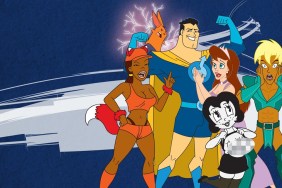Anyone who thinks there’s nothing new to be found in movie theaters during the late summer may want to reconsider when they see Samsara, the new movie from filmmakers Ron Fricke (on left) and Mark Magidson, whose continued experiments in creating visual and musical meditations have taken them across the globe to capture sights and sequences very few people ever have a chance to experience.
Fricke first began experimenting working in the nonverbal medium with Godfrey Reggio on the 1982 art film Koyaanisquatsi: Life Out of Balance in which Fricke’s distinctive time-lapse photography really turned a lot of heads. From there, Fricke joined up with Magidson to make the 45-minute IMAX film Chronos and its 1992 feature length follow-up Baraka, both times travelling across the globe with a 70mm camera to capture amazing images and assembling them into semi-narrative experiences. Both films won many technical awards at the festivals where they were shown.
It’s been twenty years since Baraka and while Fricke filled some of that time as director of photography for George Lucas’ Star Wars: Episode III Revenge of the Sith and Francis Ford Coppola’s doomed Megalopolis, he and Magidson reunited in 2006 to begin planning out their interpretation of the Samsara–birth, death and rebirth.
It took five years and they ended up visiting 25 countries to pull together 99 minutes of images that are cinema at its purest, combined with a gorgeous score featuring contemporary and traditional music from all over the world, once again composed by Michael Stearns and Lisa Gerrard of Dead Can Dance, who this time is joined by Marcello De Francisci. (Put it this way. If you like the work of Terrence Malick, especially some of the visuals in The Tree of Life, you’re likely to enjoy the experience of watching Samsara.)
ComingSoon.net had a chance to speak to Fricke and Magidson bright and early one morning last week, discussing the differences between making Baraka and Samsara and how technology changed every step of the process.

ComingSoon.net: It must be wild promoting this movie twenty years after “Baraka” as I’m sure a lot has changed.
Mark Magidson: Actually, with “Baraka” we did not do that much promotion in those days. I think honestly that this kind of media is better for us. Back then, it was just mainstream media and with an independent film, you had a hard time getting any kind of support on it, so in a lot of ways, the whole horizontal move of media is so much better for us with internet and everything.
CS: You started making “Samsara” five years ago so with all that time since doing “Baraka,” how do you even begin on this one? Is there a lot of sitting around trying to figure out what you want to film or is it more organic then that?
Magidson: Yeah, it’s that. You have a lot of time to think about it, build it, ideas, just over the time period between the two films, it all builds up.
CS: Ron, when you’re travelling around the world for other movies and commercials, do you just take notes of stuff you want to come back and film for your own films?
Magidson: Well, there’s a lot of research. You don’t drag a crew and all that equipment anywhere without a really good target list (that’s) specific, but once you get to locations, there’s a lot of opportunities to find things you hadn’t planned on. We’re researching locations that kind of fit with the concept of the film, the overall aims of the film”Samsara” meaning “birth, death and rebirth” or “impermanence”that kind of imagery. We find things wherever we got that maybe wasn’t on that list, but you have it all planned out ahead with the people who are working with us and those local countries that are setting up access.
CS: But the title of “Samsara” came up first before anything else?
Ron Fricke: Yeah, we had that concept. We’re working on these guided meditations and this one’s based on the concepts of birth, death and rebirth, like Mark was saying. They had that target subject matter that we were going after, then we had the opening and closing of the film which was the sandpainting Mandala and once we shot that in Ladaqu, India and we got it done, we thought, “Wow, we really have the film under control now as far as that we know how to open and close it,” which are really the hard things to do in a film. Once you’ve got that, it was just a matter of, “Okay, we just have to fill it in” and there’s not a lot of problem doing that, it’s just a lot of work. We had all of the research ready and a lot of it is from friends, the internet, YouTube
CS: Which was one of the resources you didn’t have 20 years ago.
Fricke: Yeah, back then it was photo books, movies and things like that 20 years ago, and you still use those. We found a lot of information from other people’s work and photo books as well.
CS: When do you know you have enough footage or everything you need and start editing it together? Or are you always adding more as you go along?
Magidson: About three years into it, we started the editing process and started to assemble the film and like Ron said, the bookends of that sandpainting sounded good, but obviously you have to get it, and it has to be visual and when that happened, we felt like we were in great shape. But you’re evaluating what you have and then at some point, you say, “Okay, we have enough to start editing with” and then you go through that. We figured we’d do some pick-up shoots into the editing process, just having been through this, that after you start seeing how the film shapes up a bit in a rough edit, maybe there’s a little more material we need to fill in a little bit of the gaps, so we went out and did a few pick-up shoots in the editing process and then we finished it.
Fricke: You could say “Samsara” had that luxury this time. I don’t think we had that on “Baraka.”
Magidson: Yeah, I think we knew going in that we needed to save space
Fricke: No, you just set it up that way. We had the room to make the film better, which was great, being able to know while we were cutting, that we could use a little bit of this
Magidson: Portrait here or something.

CS: What were some of the surprises? Things you found while you were out in the field while shooting things you knew would be in the movie that ended up being something
Fricke: Well one was this portrait of this…
Magidson: Marcos Luna, we called him “Tattoo Daddy.”
Fricke: But he wasn’t “Tattoo Daddy” when we got to the location. It was just going to be another one of these “Stare into the camera, don’t blink” portraits, until his wife brought this little baby out and he went gaga for it, and we said, “Oh my God, it’s now Tattoo Daddy” and that was just great. It was just him. We did everything we could to get it quick and not disturb it.
CS: How hard is it to “get it quick” when you’re using these 70mm cameras and how big are your crews? What’s the biggest crew you used and what’s the smallest in doing this?
Magidson: When we travel there’s just four or five of us, but we do get help with equipment. When we go to locations, we have people we work with that provide trucks and drivers and production assistants. We have a very refined equipment package after all these years. We’ve been 58 countries over “Chronos,” “Baraka” and “Samsara”we’ve done this a while so we’ve got it down to a pretty good minimum that you need but have all this capability, so it’s a combination of that. A lot of that is custom equipment that we’ve built and designed, but we have a very versatile package. The cameras, they’re not that massivethey’re not handheld at allbut there’s just a routine and a rhythm that we have shooting this way, so it’s manageable.
CS: But you always have just one camera you use for everything?
Magidson: No, we have three cameras.
CS: Can you rent cameras when you get to these countries?
Magidson: Oh, no, no, no, there’s only a handful of 70mm cameras in the world, so we have two Panavisions and a time-lapse camera that Ron designed, so that’s kind of a specialty one. There are a few times that we used all three cameras on a shoot, maybe the night time-lapse. Usually it’s one or two.
CS: I was curious about the time-lapse stuff because you’ve done a lot of that over the course of your movies. How long a period do you normally shoot for?
Fricke: All different. It depends on the subject how you do it, but time lapse has this great, great ability of just taking ordinary things and making them look unordinary so that’s why we like to undercrank the camera and then you can get into putting time between the frames. The longest would be shooting all night to get a starfield and that takes eight hours and you get ten seconds of screen time.
CS: Do you just find a good place to set the camera up and then have people guarding it over that time?
Fricke: No, you set it up, preview the move and fire it off, and it may take 20 minutes, may take 2 hours or it may take eight.
Magidson: It’s all based on what the shot is.
Fricke: If it’s daylight, shadow moving or people, it’s all different. We know what the effect is going to be. We just usually set it up and get that thing running and then I’ll probably go off and start shooting some other shots while that thing is cooking.
Magidson: And at nights, you pretty much leave it and come back the next day. Usually, we’re in very remote places for the night cinematography. There’s no lights around there, because that would mess up the shot
Fricke: But this style of filmmaking, we’re not just shooting 24 frames per second. In order to get these images, to get the content we’re looking forwhich is the images. We don’t have any actors or dialogue so it’s the image that’s the main character so we shoot all kinds of film speeds, not just 24 frames per second. We overcrank, we shoots speeds under that, we time lapse, that’s what gets the visual personality into the film.

CS: I want to ask about the changes in technology since your last movie. We’re in an interesting time where 70mm is getting a lot of attention because Paul Thomas Anderson’s new movie “The Master” is being projected 70mm and there’s a new doc this week called Side to Side, which is about digital vs. film. There’s an interesting conversation going on right now. You guys have been using the same cameras but how have the technological changes made it easier to make this guy, besides having the internet for research. How have you used technology in finishing this movie compared to “Baraka”?
Fricke: Well, I think the biggest thing was the new film stocks we used and then having Panavision’s back-up with those cameras. Their optics were really good and thenMark can explainbut we had the best of both worlds here, not only with film but digital.
Magidson: Well, our output is digital even though we image-captured on film in 65mm negative. We’re not outputting this film to film, we’re outputting to DCP, a digital output, so that’s our preferred way of showing the film and that really has to do with the combination of the old 60-year-old film technology, combined with this high-tech cutting edge super high resolution scanning at 8K that we did on the film that would turn the visual file into a size of over 20 terabytes of a digital file which was then reduced down to a conventional resolution that you could output to Blu-ray eventually or 4K DCP but the amount of detail it retains is just phenomenal, so we took the film into a digital environment but you get all the quality of the large negatives embedded into the file. We’re doing a combination of what we think is the best of both technologies, the best way to image capture and then the best way to output. Once we get into the digital environment, we’re able to refine the imagery, we’re able to save shots that we’d have to otherwise trash really for various reasons. It’s a different process then with “Baraka.” We never cut our negative as we did with “Baraka” to make the film elements. We scanned our negative and once we got it into the digital environment, that’s what we’ve been working with.
For editing, we did a Telecine to an Apple Pro Res and we edited it in Final Cut. They’re really a beautiful way to edit and a very good quality work copy for editing purposes. It’s good enough that you can screen it on a decent size screen and it looks pretty good so you get a good hit off of it while you’re assembling the film.
CS: Was “Baraka” always screened in 70mm so were there a lot more projectors that it wasn’t a problem getting the movie screened?
Fricke: Oh, they’re all over the place, yeah.
Magidson: But we do 35 prints of “Baraka” also. It was an anamorphic squeeze and it’s everywhere, it was easily shown.
CS: When you started making this five years ago, digital cameras weren’t anywhere at where they are now. That doc I mentioned talks about the evolution of those cameras to a resolution that’s insane, so have you started playing with them at all?
Fricke: Yeah, I work in digital. I love it. Another year from now there’ll be 8K, 10K cameras out there. Four or five years ago when Mark and I started, they just weren’t ready to go on the road. It was all 2K.
CS: So if you did another movie, would that be a consideration or would you use those as a back-up to the film cameras?
Magidson: It’s a good question and it’s a big price to shoot in film where you’re doing our kind of films where you’re travelling a lot and it’s very hard to get film stock in and out, exposed and unexposed and not having it X-rayed, across borders and on flights. You really can’t take it on flights like we could with “Baraka”you have to ship it DSL or FedEx to be sure it’s not X-rayed, so it’s really hard to work in film now and it’s not getting any easier. As digital gets to where it’s gone, you have to really think hard about it. It’s probably sad to say but it is going to move to a point where it just doesn’t make sense to use film.
Fricke: But it’s really nice to have that background in film, working in large wide-screen 70 format just gives you this frame of reference about capturing these images in a way that I don’t think you would learn it through digital. But you can apply it to digital cameras.
CS: I’d also think it’s hard to get the cameras maintained.
Fricke: Well, you know, they’re just workhorses. They just run, run, run. We had some loose parts in one and the damn thing still kept running. (chuckles)

CS: One of the scenes in the movie which is really quite amazing is the bird’s eye view of the Kaaba in Mecca, which is something that we’ve never seen in a film before quite in that way.
Fricke: That’s because that location didn’t exist before. It was a 40-story new building that was right next to the mosque, so we were able to get up on the roof and almost didn’t get it because our fixer fixed it with the building security but not with the owner. The owner showed up right in the middle of the shoot, it was during Ramadan and there were so many pilgrims around there, it was amazing. When they arrived on the roof they said, “You guys gotta get out of here, you don’t have permission to be up here.” We had a little talk and it was the sheik of the family and I said, “Look, it’s the most beautiful thing and the world should see this.” There was just this long pause and he just stared at us and said, “You’re welcome. Come back after we finish praying.” So we got it.
CS: I wasn’t sure, because it looks like a helicopter shot and I just don’t see any way to get a helicopter to hover above that sacred place.
Fricke: But it looks like a helicopter shot.
Magidson: The steadiest helicopter shot.
Fricke: It was just wonderful.
CS: The other thing I wanted to ask about the guy who was doing performance art that seemed almost like performance art. Who is that guy?
Magidson: He’s a French artist named Olivier de Sagazan, and we found him on YouTube. You know, we have a series of performances in the film. There’s the Bali girls we open up, the three girls, and there’s the prison performance, there’s his performance. There’s the thousand hands performance that you see. That was one of the subject matter categories that we were trying to find dynamic performance artists across a range of emotions, so we found him and put him in a suit behind a desk and he did his thing. That’s what he does.
CS: It’s really amazing as you watch this movie to try to figure out where things were shot and there’s really only so much information you can find in the production notes.
Fricke: His performance was all about the shadow of the dark side, about the things within you that you don’t want people to know or see. He really hit on that. It’s a surprise for a lot of people when that sequence comes up because it’s so unexpected.
CS: It reminded me of the guy ripping his own face off in “Poltergeist” and it gets more and more intense. Just the whole movie in general really runs the gamut of emotions between those first few minutes and the end even with things like the guy being buried in a coffin shaped like a gun.
Fricke: For real. We found that location just by seeing that there were fantasy coffins and we said, “God, we have go to there.”
Magidson: Here, you go down these streets that have these car dealerships Toyota, Honda and Chrysler and there, they have a street that’s just coffin dealerships all up and down with fantasy coffins. It’s just a cultural thing in Ghana.
Fricke: And then, like they said, the happy accident is that they’re having a funeral and this guy is getting buried in a gun.
CS: Did you guys know how he died? Natural causes?
Fricke: (shakes head) Or even why he’d want to be buried in a gun.
CS: When I talk to people about this movie, I mention that it’s by the filmmakers of “Baraka” and I’d say 3 out of the 5 people respond “Yeah, I saw that when I was stoned.” You spend so much time making these movies and I wonder how you feel about them becoming known as stoner movies. It is a different type of meditation so I assume it’s viable.
Fricke: I don’t know. I never thought about that.
Magidson: Yeah, I don’t know what to say. We hope you can get to a place, an inner altered state, just from the film. I think that’s what you want as a filmmaker with films like this. Films are designed to work that way because we’re tryingas Ron, calls it a “flow”we’re trying to pull you through this experience in a seamless flow that doesn’t let you out of the flow, the way the sequences are connected and everything. I hope you can get to that place
Fricke: That’s really what we’re trying to say with the film. It’s really about how everything is connected and doing that without beating you up and explaining this or that, just letting you flow along with it. Because the flow is the inner connection. This guided meditation may inspire people to go get a little stoned, I don’t know.

CS: Having seen “Samsara” unstoned, it really had a similar effect on me, where I was in one state as it began and then it drew me in and I felt like I left the movie having experienced something life-changing.
Magidson: Yeah, and we’re walking the fine line between trying to not judge the subject matter as good or bad or have a strong political view with it. We’re walking that line. There’s some of that but once you get into that place where you’re trying to tell the audience something or give them an opinion, you create an intellectual thought process within the viewer that we’re trying to stay away from in this kind of filmmaking.
Fricke: It’s not that easy when you’re in the cutting room and you start cutting images together, about three or four images in a string and it suddenly wants to say something about the subject you’re working with so like Mark said, we just try to keep it in the middle and then we form little blocks of content and then we set them aside until we had enough. We did all of this without music or sound effects. We just let the image guide the flow and then we started stringing the blocks together.
CS: I’m glad you mentioned one of the things I wanted to ask about, which is the music, because that’s a huge part of the film.
Fricke: Half of it.
CS: I found it interesting how certain music was used with certain images in ways that might not be expected, so you do all your editing before it goes out to the three composers?
Magidson: We did this time, but we didn’t do that with “Baraka.” With this film, we edited it completely in silence and then did the music.
Fricke: It’s an interesting style of cutting.
Magidson: So yeah, we had two composer groupsthere was Michael Stearns, who we had worked with on “Chronos” and “Baraka” and Lisa Gerrard and Marcello De FrancisciLisa had done some work on “Baraka” as well. We had these sequences and they would work on those sequences as separate pieces and we’d fit them together and connect them and that’s how it worked and you get real music that way because they’re composing to a three or five minute sequence or whatever that is and they’re composing a piece of music that’s five minutes. It’s a piece of music you can listen to as music as well that interprets their feelings to know that imagery in that sequence visually, so they’re kind of interpreting it musically. They just did a phenomenal job.
CS: You never change any of their musical cues in terms of putting it over other visuals?
Magidson: That happened once or twice.
Fricke: If it works, it works.
CS: I was thinking there were a couple places where the music was just unexpected for the visuals and that’s why I wondered if that was their interpretation or that was a specific direction you gave them?
Magidson: It’s not like they deliver a finished piece of music without
they’re sending us musical sketches, musical concept ideas and we tell them whether that’s a good direction to head in or not, so they’re being guided a bit, but then they get in sync with it.
CS: How long does it take to get the music where you want it?
Magidson: It took about six or seven months, the scoring process.
As we wrapped up and said our goodbyes, saying that we hope it wouldn’t be another 20 years before we have a chance to talk to the duo, Fricke closed by saying that they weren’t getting any younger and it would be likely that they would do something new sooner rather than later.
Samsara opens in New York at the Landmark Sunshine and in Seattle on Friday, August 24, and in Los Angeles on August 31.
